An indepth look at this popular cruising catamaran
Late in 2008 I was contacted by a business colleague and asked if my wife and I would like to join him and his wife aboard a new 2009 Lagoon 440 for a week long charter in the British Virgin Islands (BVI)…
It seemed like a perfect idea ……………except for the BVI part! Having lived in the BVI for some 8 years managing charter fleets of up to 90 yachts, you can probably imagine that I could think of some other exotic location in the world to spend a week of precious vacation time. Boy was I wrong and what a pleasant surprise the trip turned out to be! I have often wondered how many people who live full time in New York City have never been to the top of the Empire State Building and who take their surroundings for granted. Then it suddenly dawned on me that I was one of those people who thought the same of my surroundings when I lived in the BVI. Needless to say, I had forgotten just how great the BVI really is for a sailing vacation. Perfect winds out of the east every day are hard to beat but the star of this great vacation was the boat herself.
Heading to the Drake Channel
After just 6 days sailing in the BVI on the Lagoon 440 (….), I had to admit that I was really impressed with the ease of sailing this boat. What makes this statement most interesting though is that I have sailed the L440 many, many times since its introduction in 2004 but never for this long of a period and I have never actually lived aboard. And there was me thinking I knew everything there was to know about this model……. (Don’t tell my boss!)
The History
Lagoon certainly isn’t a new company but their yachts do seem to exhibit many new and innovative design ideas that work effortlessly together. From its initial introduction, the L440 was a completely new yacht from the ground up, not a rework of an old hull. Neither was it a modification of an existing model nor a catamaran that was stretched two feet and called a new model like so many other catamarans in the market today. The brains behind her, Bruno Belmont of CNB Lagoon, really focused on previous owners’ feedback and their ideas of what a cruising catamaran should be for today’s cruising sailors. Wow, what a concept, especially for the French!! Designing a boat based on the needs of the user… do you think this concept will ever catch on? These clearly are the reasons why the L440 is so easy to sail and enjoy.
A bright and spacious saloon
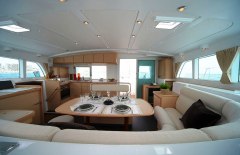 This catamaran is truly a very comfortable cruising cat that is loaded with innovative features as standard. There are many things which make the L440 unique and set it apart from any other catamaran out there but Lagoon really broke many paradigms in catamaran design and construction with their very recognizable vertical salon windows, which have become their trademark since having first been seen in the mid-nineties in the L410 and L470 design. All their current designs are by the renowned French naval architectural firm based in Paris, VPLP (Van Peteghem Lauriot Prevost) Navel Architect Designs. A little known fact about Lagoon is that in 2000 Lagoon became the production division of CNB (Construction Naval Bordeaux) that is headquartered in a 300 year-old shipbuilding facility on the Garonne River in Bordeaux, France. CNB is the very high-end custom boat building division of the Beneteau Group and benefits from the high technology carbon fiber and resin infusion yacht construction techniques. CNB specialize in building 60ft-120ft carbon fiber and aluminum monohulls and catamarans, so Lagoon owners benefit from the vast support provided by the Lagoon and Beneteau network of dealers worldwide.
This catamaran is truly a very comfortable cruising cat that is loaded with innovative features as standard. There are many things which make the L440 unique and set it apart from any other catamaran out there but Lagoon really broke many paradigms in catamaran design and construction with their very recognizable vertical salon windows, which have become their trademark since having first been seen in the mid-nineties in the L410 and L470 design. All their current designs are by the renowned French naval architectural firm based in Paris, VPLP (Van Peteghem Lauriot Prevost) Navel Architect Designs. A little known fact about Lagoon is that in 2000 Lagoon became the production division of CNB (Construction Naval Bordeaux) that is headquartered in a 300 year-old shipbuilding facility on the Garonne River in Bordeaux, France. CNB is the very high-end custom boat building division of the Beneteau Group and benefits from the high technology carbon fiber and resin infusion yacht construction techniques. CNB specialize in building 60ft-120ft carbon fiber and aluminum monohulls and catamarans, so Lagoon owners benefit from the vast support provided by the Lagoon and Beneteau network of dealers worldwide.
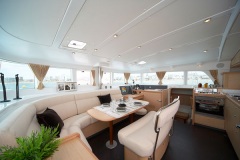 Lagoon has a wealth of experience with well over 1,800 catamarans built to date and have been a leader in design and innovation for over 20 years when they took the cruising catamaran market by storm with its ground-breaking fly-bridge design.
Lagoon has a wealth of experience with well over 1,800 catamarans built to date and have been a leader in design and innovation for over 20 years when they took the cruising catamaran market by storm with its ground-breaking fly-bridge design.
All the clever design features really add up to a yacht that is fun and easy to sail, but ask yourself this question: Why do you buy a sailing yacht in the first place? To sail, of course! So why make it difficult? If it is a challenge to easily sail, where is the fun? With this in mind, the Lagoon 440 is outfitted with all of the control lines led to the centrally located fly-bridge helm and is an indisputable convenience appreciated by any sailor.
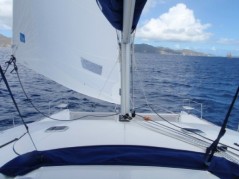 Everyone knows a true fly-bridge catamaran design offers great visibility and a center helm position exactly where you want it for ease of handling when docking but it is also true that you actually can’t see the edge of the swim platform from the fly-bridge. So-what!!!! Let me pose a question: can you see the fenders on your car when you are parking? No!! However you do have a pretty good idea of where they are located in relation to your car and the parking space. Simply ask your crew to let you know how close you are to the aft part of the dock. How difficult was that? Here is a very good rule of thumb…if you can no longer see the dock, you are too close! Many people wonder whether or not the fly-bridge has been a success and the proof is in the pudding. There have been almost 400 Lagoon 440s built since her introduction in 2004, making her the most popular catamaran over 40 feet ever built – PERIOD.
Everyone knows a true fly-bridge catamaran design offers great visibility and a center helm position exactly where you want it for ease of handling when docking but it is also true that you actually can’t see the edge of the swim platform from the fly-bridge. So-what!!!! Let me pose a question: can you see the fenders on your car when you are parking? No!! However you do have a pretty good idea of where they are located in relation to your car and the parking space. Simply ask your crew to let you know how close you are to the aft part of the dock. How difficult was that? Here is a very good rule of thumb…if you can no longer see the dock, you are too close! Many people wonder whether or not the fly-bridge has been a success and the proof is in the pudding. There have been almost 400 Lagoon 440s built since her introduction in 2004, making her the most popular catamaran over 40 feet ever built – PERIOD.
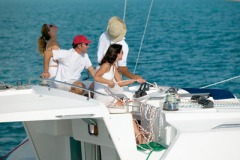 Furthermore, the fly-bridge design has been incorporated in every new Lagoon designs over 44 feet since the introduction of the L440, including the L500 and the new 2010 model launch of the L620. Would you really build new models with a design that had not proven successful previously? The L440 fly bridge has a well designed, concealed, fully-retractable bimini with a removable, clear windscreen, all part of the standard equipment package. This offers a tremendous amount of protection and is very useful for long range cruisers. An additional suggestion is to add clear side-panels that can be made by any local canvas shop. So picture the scene! You motor out of the marina, point into the wind, put on the autopilot to steer into the wind and raise the main sail. Within two minutes the sails are up and you are sailing. Whew, but that was tiring… This was our exact procedure (and total work out!) three times per day. The L440 was so easy to sail that our wives got into the act and were finding it just as enjoyable as we were to be fully involved in the sail handling. There goes our male usefulness!
Furthermore, the fly-bridge design has been incorporated in every new Lagoon designs over 44 feet since the introduction of the L440, including the L500 and the new 2010 model launch of the L620. Would you really build new models with a design that had not proven successful previously? The L440 fly bridge has a well designed, concealed, fully-retractable bimini with a removable, clear windscreen, all part of the standard equipment package. This offers a tremendous amount of protection and is very useful for long range cruisers. An additional suggestion is to add clear side-panels that can be made by any local canvas shop. So picture the scene! You motor out of the marina, point into the wind, put on the autopilot to steer into the wind and raise the main sail. Within two minutes the sails are up and you are sailing. Whew, but that was tiring… This was our exact procedure (and total work out!) three times per day. The L440 was so easy to sail that our wives got into the act and were finding it just as enjoyable as we were to be fully involved in the sail handling. There goes our male usefulness!
 The standard electric halyard winch made it so quick and easy to sail from the fly-bridge that we choose to sail everywhere rather than turn on the motors. Even for short island hops of only 5 miles we opted to sail instead of powering. By the end of the week we had burned only 42 gals of fuel and that included running the generator at night for the air conditioning and a couple of times during the day. Now that is efficiency, especially when you consider that we covered approximately 130 miles in our week in the BVI. What occurred to us at the end of the trip was that if your cruising catamaran is easy to sail then by deduction it will also be more fuel efficient. Our particular L440 was equipped with the option of 2-speed Harken winches. As far as this sailor is concerned the option of all electric winches is a must. The electric halyard winch comes standard, with the winches for the genoa sheets, mainsheet, and furling lines all as options. Electric winches are a great example of a manufacturer option that is well worth the investment and you will certainly get this reflected in resale.
The standard electric halyard winch made it so quick and easy to sail from the fly-bridge that we choose to sail everywhere rather than turn on the motors. Even for short island hops of only 5 miles we opted to sail instead of powering. By the end of the week we had burned only 42 gals of fuel and that included running the generator at night for the air conditioning and a couple of times during the day. Now that is efficiency, especially when you consider that we covered approximately 130 miles in our week in the BVI. What occurred to us at the end of the trip was that if your cruising catamaran is easy to sail then by deduction it will also be more fuel efficient. Our particular L440 was equipped with the option of 2-speed Harken winches. As far as this sailor is concerned the option of all electric winches is a must. The electric halyard winch comes standard, with the winches for the genoa sheets, mainsheet, and furling lines all as options. Electric winches are a great example of a manufacturer option that is well worth the investment and you will certainly get this reflected in resale.
The helm on the L440 has a solid feel. Most cats have a very neutral helm that provide very little feed-back. By “feed-back” I mean the weather helm feeling you find on most monohulls where, as the yacht heals over, it has a tendency to steer up into the wind. If you have ever sailed a very high-end racing monohull or taken the helm of an Americas Cup yacht you will find a very balanced helm, even in higher winds and extreme healing angles. As you can imagine, a catamaran does not heal and therefore provides a very balanced helm.
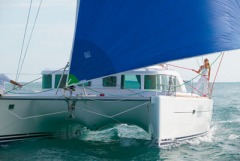 Even sailing in 20-30kts of apparent wind the L440 has a very relaxed helm for a catamaran of this size. With proper trim we were able to carry a full main and genoa on all points of sail the entire week. Having a yacht that can sail through such wide wind-ranges without reefing is a great benefit as you do not need to put-in or take-out a reef very often. Close-hauled sailing was best accomplished by moving the traveler well above center line and then easing the mainsheet until the boom is back on centerline and the top third of the main sail is twisted off to leeward. With a fully battened mainsail like the L440 this is a very effective depowering technique without having to reef the main. (This is also known as a fisherman’s reef.) Reefing the L440 is well engineered and simple to operate. We found that one person acting alone could put in a reef in under a minute.
Even sailing in 20-30kts of apparent wind the L440 has a very relaxed helm for a catamaran of this size. With proper trim we were able to carry a full main and genoa on all points of sail the entire week. Having a yacht that can sail through such wide wind-ranges without reefing is a great benefit as you do not need to put-in or take-out a reef very often. Close-hauled sailing was best accomplished by moving the traveler well above center line and then easing the mainsheet until the boom is back on centerline and the top third of the main sail is twisted off to leeward. With a fully battened mainsail like the L440 this is a very effective depowering technique without having to reef the main. (This is also known as a fisherman’s reef.) Reefing the L440 is well engineered and simple to operate. We found that one person acting alone could put in a reef in under a minute.
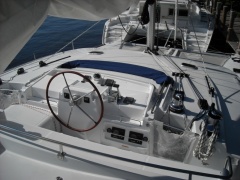 It was a simple matter of easing the main halyard and tightening the reef line, which was one continuous line that pulls down the leech and luff of the mainsail at the same time. This entire maneuver is accomplished safely from the helm on the flybridge. One of the huge benefits for a long range cruiser is that you never need to leave the helm to accomplish any sail maneuvers because every control line is led to the helm at the fly bridge. The rigging designers on this boat even thought to include a down-haul to help retrieve the mainsail when lowered. It consists of a small line attached to the head of the mainsail and leads it to the starboard side of the fly-bridge. Tip— a little extra halyard tension on both the main and genoa moves the draft aft on the sail plan reducing weather helm. We never felt we were fighting the helm on our trip and as a result we spent more time hand-steering (i.e. no autopilot) and were confident comfortably short-tacking in West End and other narrow cuts.
It was a simple matter of easing the main halyard and tightening the reef line, which was one continuous line that pulls down the leech and luff of the mainsail at the same time. This entire maneuver is accomplished safely from the helm on the flybridge. One of the huge benefits for a long range cruiser is that you never need to leave the helm to accomplish any sail maneuvers because every control line is led to the helm at the fly bridge. The rigging designers on this boat even thought to include a down-haul to help retrieve the mainsail when lowered. It consists of a small line attached to the head of the mainsail and leads it to the starboard side of the fly-bridge. Tip— a little extra halyard tension on both the main and genoa moves the draft aft on the sail plan reducing weather helm. We never felt we were fighting the helm on our trip and as a result we spent more time hand-steering (i.e. no autopilot) and were confident comfortably short-tacking in West End and other narrow cuts.
Tacking was never a problem and the L440 glides effortlessly through the wind without any sign of stalling. With the Lagoon 440 you can choose several sail configuration options to better fit the type of sailing you prefer. The standard mast height off the water is 70’. If you need an intracoastal friendly rig there is an option for a 63’ rig. In 2009 Lagoon introduced a square-top main sail that is 20% larger than the standard full roach mainsail, which I personally tested on their latest model, the new Lagoon 400 in La Rochelle, France last month. The sail shape was the crispest I have ever witnessed and in light winds had superb performance. If you are a performance-minded sailor, you have the options of a spinnaker and roller-furling gennaker. The furling gennaker is the more versatile of the two choices and the Doyle Sailmakers’ Reacher with a UV protective strip is highly recommended.
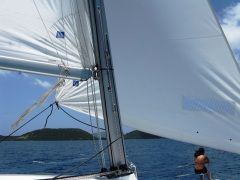 The gennaker can be used in a wide range of winds and is effective 80 degrees to 140 degrees off the wind. The gennaker is especially useful in light winds. You can expect a 3 knot increase in speed in most sailing situations. If your voyage takes you on a long down-wind course you can choose to only use the gennaker and leave the mainsail in the sail-bag until your course changes to more of a reach. To further improve performance, many long-range sailors consider going for a pair of folding propellers. When sailing with folding propellers you will see an increase of 1-2 knots in sailing speed, which helps make a long trip just that little bit shorter. The L440 “cat” is certainly no “dog”. We were able to sail as high at 40 degrees off the wind and maintain good speed thanks to the well designed keels and rig.
The gennaker can be used in a wide range of winds and is effective 80 degrees to 140 degrees off the wind. The gennaker is especially useful in light winds. You can expect a 3 knot increase in speed in most sailing situations. If your voyage takes you on a long down-wind course you can choose to only use the gennaker and leave the mainsail in the sail-bag until your course changes to more of a reach. To further improve performance, many long-range sailors consider going for a pair of folding propellers. When sailing with folding propellers you will see an increase of 1-2 knots in sailing speed, which helps make a long trip just that little bit shorter. The L440 “cat” is certainly no “dog”. We were able to sail as high at 40 degrees off the wind and maintain good speed thanks to the well designed keels and rig.
We frequently saw 10 knots plus boat-speed as measured on the Raymarine E120 chart plotter, even though the actual boat we sailed had fixed propellers and the standard main and genoa sail package. Max speed under power with the 54 hp Yanmar option is 10 knots @ 3,400 RPM. Performance @ 3,100 RPM is 9.1 knots with a fuel burn of 4.6 GPH. A more modest 2,700 RPM yields a cruise speed of 7.7 knots. In 2004-2006 Lagoon offered an option for twin 75hp engines but the speed increase vs the fuel usage increase was only very marginal and the Lagoon discontinued this option and replaced it with the more fuel efficient 54 hp option.
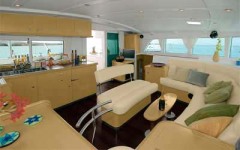 The new interior scheme that Lagoon started in 2008 is light and airy. The salon has very comfortable cushions with neutral-color upholstery options. The Alpi wood interior is a very high-end Italian laminate that is an eco-friendly, renewable resource. The flooring is an aluminum-oxide material, just like Pergo, on composite floor boards in the very “trendy” African wenge wood-color. This is a robust material that is fade and scratch resistant. Lagoon only offers one color for the interior work finishes.
The new interior scheme that Lagoon started in 2008 is light and airy. The salon has very comfortable cushions with neutral-color upholstery options. The Alpi wood interior is a very high-end Italian laminate that is an eco-friendly, renewable resource. The flooring is an aluminum-oxide material, just like Pergo, on composite floor boards in the very “trendy” African wenge wood-color. This is a robust material that is fade and scratch resistant. Lagoon only offers one color for the interior work finishes.
One thing all the current Lagoon models have in common is large hull volume. Believe it or not, the L440 has 880 sq ft of living space. You will really like the large “Island-berths” (i.e. you can walk around the berth on three sides) for easy in and out. This design is especially useful when you are sharing a berth with someone who does not like to be woken-up by their partner getting out of bed for a midnight visit to the head. The large volume and width in the hull sections is what really makes this style of berth possible.
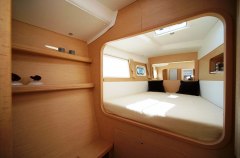 The berths are 6’9” long and 5’4” wide with a comfortable 6” thick mattress. Lagoon offers an option for under-bed-slats that add extra cushion. For a little more money, you can buy a custom mattress from an aftermarket source that will be even more comfortable than your bed at home. On the outboard side of each cabin you will find a large “picture window” with a unique coating that allows you to see out very clearly but, appears white, just like the hull color from the outside. This keeps the cabin cool and offers privacy without inhibiting your view.
The berths are 6’9” long and 5’4” wide with a comfortable 6” thick mattress. Lagoon offers an option for under-bed-slats that add extra cushion. For a little more money, you can buy a custom mattress from an aftermarket source that will be even more comfortable than your bed at home. On the outboard side of each cabin you will find a large “picture window” with a unique coating that allows you to see out very clearly but, appears white, just like the hull color from the outside. This keeps the cabin cool and offers privacy without inhibiting your view.
Can you imagine waking-up in a beautiful anchorage and having that view from your cabin before even leaving your berth? Head room is 6’9”- 7’3” in the salon and is great for tall guys like me at 6’2”. There are two small hatches overhead to keep the heat out and plenty of ventilation from the forward opening Lewmar hatches and the aft sliding doors.
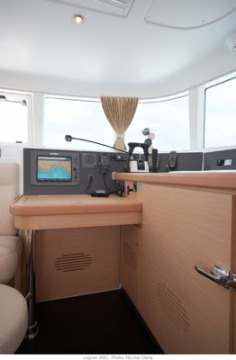 Looking forward from the huge “L” shaped chart table you can see almost a 360 degree view from the salon, Nav. station and galley. The forward facing navigation station has ample space for many electronic options, including 12” navigation displays. On the starboard side there is space where you will find the Raymarine joystick control for inside-steering, along with inside engine controls and throttles. The chart plotter and radar screen just below your forward facing view, when sitting at the Nav. Station, is a fantastic advantage for long range passages. Any seasoned sailor will welcome the proposition of sitting inside warm and dry in foul weather conditions.
Looking forward from the huge “L” shaped chart table you can see almost a 360 degree view from the salon, Nav. station and galley. The forward facing navigation station has ample space for many electronic options, including 12” navigation displays. On the starboard side there is space where you will find the Raymarine joystick control for inside-steering, along with inside engine controls and throttles. The chart plotter and radar screen just below your forward facing view, when sitting at the Nav. Station, is a fantastic advantage for long range passages. Any seasoned sailor will welcome the proposition of sitting inside warm and dry in foul weather conditions.
We prepared several meals underway from the giant galley with an excellent view. If you found the need to step inside from the fly-bridge for a snack while sailing you can do so with complete confidence. The galley is equipped with three polished stainless steel sinks, a four burner stove and separate oven making the preparation of just about any meal possible, even with large crews onboard. Just think of it, there is enough Corian counter space for multiple “Galley Slaves” to toil effortlessly.
The option for the upgraded stainless steel matching refrigerator and water cooled freezer are highly recommended. They look great and work well. No one can claim there is not enough storage space in this galley. We may have found a yacht under 50ft. that might be guilty of “too much” storage space as there really is a ton of storage space. The aft-facing sliding window in the galley has a convenient pass-though that permits the chef to pass meals directly from the galley to the hungry sailors in the cockpit but most importantly of all, this window allows whoever is cooking in the galley to be included in the conversation in the aft cockpit area.
The L440 is offered in the owner’s version with three cabins and three heads. Both versions are available with an optional salon conversion to lower the salon table for an extra queen berth. Another option is to add two crew cabins and also a head/shower in the bow compartments for 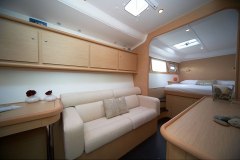 crew or younger and smaller members of the family. The three cabin layout is most common and has a slightly higher resale value even though it cost less than the four cabin version when new. The 4/4 layout is the perfect layout for a successful charter machine.
crew or younger and smaller members of the family. The three cabin layout is most common and has a slightly higher resale value even though it cost less than the four cabin version when new. The 4/4 layout is the perfect layout for a successful charter machine.
The aft cockpit is optimized for convenience with a pass-through window between the galley and cockpit. The Corian topped sink unit on the port side of the cockpit has space below for an optional cockpit fridge and ice maker. This is a great place to make drinks and stage food for the barbeque. There are truly three distinct deck seating areas on the L 440. Firstly, you have the convivial and vast forward cockpit area that recesses into the deck for entertaining and sailing in calm weather. This neighborhood also includes the two bow pulpit seats and trampolines. Secondly, there is the fly-bridge with bench seating for up to seven.
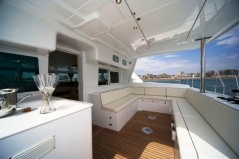 Finally, at the stern there is the well-protected aft cockpit that is free of lines and winches cluttering up valuable entertaining and lounging space. I have been on demo sails with up to 25 people onboard with ample space for everyone to sit comfortably. What a truly amazing feat for a 44ft sailing yacht! OK, want to see a really good idea in action? The salon table is interchangeable with the cockpit table if you choose to dine outside. If no large table is needed, the table top can be completely removed and stored in a drop-down compartment on the underside of the hard top bimini in the aft cockpit. There is another smaller narrow table that can be fit with shorter table legs and used as a coffee table or it can fit on the longer legs and be used as a café style table in either the salon or cockpit. This feature alone makes the configuration of L440 versatile enough to accommodate so many possible different living scenarios. It’s like the “transformer” of cruising cats! Table storage in the underside of the hard top bimini is absolutely ingenious! It is a small thing but, worth noting.
Finally, at the stern there is the well-protected aft cockpit that is free of lines and winches cluttering up valuable entertaining and lounging space. I have been on demo sails with up to 25 people onboard with ample space for everyone to sit comfortably. What a truly amazing feat for a 44ft sailing yacht! OK, want to see a really good idea in action? The salon table is interchangeable with the cockpit table if you choose to dine outside. If no large table is needed, the table top can be completely removed and stored in a drop-down compartment on the underside of the hard top bimini in the aft cockpit. There is another smaller narrow table that can be fit with shorter table legs and used as a coffee table or it can fit on the longer legs and be used as a café style table in either the salon or cockpit. This feature alone makes the configuration of L440 versatile enough to accommodate so many possible different living scenarios. It’s like the “transformer” of cruising cats! Table storage in the underside of the hard top bimini is absolutely ingenious! It is a small thing but, worth noting.
The swim ladder on the transom is concealed into the last step of the swim platform. This makes for an uncluttered place to embark on snorkel missions.
Keeping the swim ladder out of the way when boarding your dinghy is so useful. Hey, Lagoon if you’re reading this, please incorporate this same design on the L400 and L420!!
Overall length 44’8”
Length on waterline 41’10”
Overall beam 25’3”
Draft 4’3”
Mast clearance(std mast) 70’3’’
Mast clearance(short mast) 63’
Light displacement (EC regulations) 26791 lbs
Full batten main 796 sq. ft (std)/632 sq.ft (short)
Furling jib 452 sq. ft (std) / 436 sq.ft (short)
Spinnaker (option) 1560 sq. ft (std) / 1130 sq.ft (short)
Genaker (option) 968 sq. ft (std) / 646 sq.ft (short)
Water tank capacity 3 x 79 US Gal
Fuel tank capacity 2 x 86 US Gal
Standard engine rating 2 x 40 HP
Engine upgrade (option) 2 x 55 HP
Interior finish Light oak Alpi and non skid laminated wenge for the wood floor
Naval architects Marc Van Peteghem & Vincent Lauriot Prévost EEC Certification A: 12 pers –
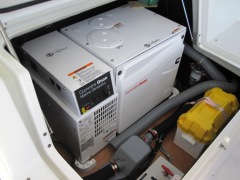 Lagoon has a pretty simple philosophy. If the generator and engines are easy to access, you will check and maintain them more often. If you do that they will be more reliable. If they are more reliable you will be happier with your boating experience on your catamaran. Therefore the L440 has the easiest generator access in a yacht of this size and the impeller, water strainer, battery, fuel filter and oil fill/check are all within arms-reach in the cockpit.
Lagoon has a pretty simple philosophy. If the generator and engines are easy to access, you will check and maintain them more often. If you do that they will be more reliable. If they are more reliable you will be happier with your boating experience on your catamaran. Therefore the L440 has the easiest generator access in a yacht of this size and the impeller, water strainer, battery, fuel filter and oil fill/check are all within arms-reach in the cockpit.
If you’re fitting a chart plotter at the fly bridge then a NavPod to house the E 120 Raymarine chart plotter is a must. We found this easy to use and extremely convenient. Have you ever noticed on many boats the electrical panel is on hinges? Guess what happens every time you open that panel? It bends and fatigues the wire connections. This might not happen often during your term of ownership. But when your yacht is being built the technicians are in this space constantly. You can imagine what happens if you install any aftermarket electronics. Lagoon has designed an electrical control panel that has easy access from the top and has no hinges to fatigue those fragile wire connections on your vital electrical system.
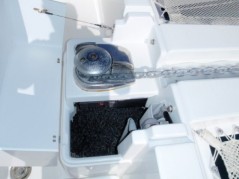 I mentioned above the nacelle that contains the anchor chain locker. Moving further aft under the bridge-deck the famous Lagoon gull-wing shape adds extra torsional-strength without adding weight. This shape is exceptional at dissipating wave energy when impacting the bridge-deck in offshore sea conditions. The large forward and aft hull section of the L440 enable it to have a payload rating of 6,500 lbs. In rough, offshore sea conditions the fuller hull sections prevent the bows from diving into the water when coming off a wave and greatly reduce bridge-deck pounding. The volume in the transoms also prevents the bows from rising up when approaching large waves. Think of the difference between pushing a knife blade (narrow old-style hull designs) in the water and pushing a balloon (fuller volume Lagoon style hull designs) into the water.
I mentioned above the nacelle that contains the anchor chain locker. Moving further aft under the bridge-deck the famous Lagoon gull-wing shape adds extra torsional-strength without adding weight. This shape is exceptional at dissipating wave energy when impacting the bridge-deck in offshore sea conditions. The large forward and aft hull section of the L440 enable it to have a payload rating of 6,500 lbs. In rough, offshore sea conditions the fuller hull sections prevent the bows from diving into the water when coming off a wave and greatly reduce bridge-deck pounding. The volume in the transoms also prevents the bows from rising up when approaching large waves. Think of the difference between pushing a knife blade (narrow old-style hull designs) in the water and pushing a balloon (fuller volume Lagoon style hull designs) into the water.
By Staley Weidman III CPYB – Staley Weidman is one of the top catamaran brokers in the United States and a recognized expert in yacht sales.
Multihulls Magazine Issue: September / October 2009
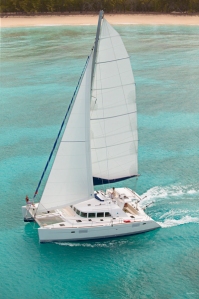
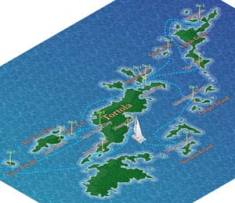









Posted on 20 January 2012
0